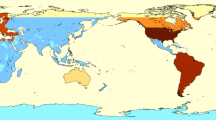Abstract
When planning a satellite gravity gradiometer (SGG) mission, it is important to know the quality of the quantities to be recovered at ground level as a function of e.g. satellite altitude, data type and sampling rate, and signal variance and noise. This kind of knowledge may be provided either using the formal error estimates of wanted quantities using least-squares collocation (LSC) or by comparing simulated data at ground level with results computed by methods like LSC or Fast Fourier Transform (FFT).
Results of a regional gravity field recovery in a 10o×20o area surrounding the Alps using LSC and FFT are reported. Data used as observations in satellite altitude (202 or161 km) and for comparison at ground level were generated using theOSU86F coefficient set, complete to degree 360. These observations are referred to points across simulated orbits. The simulated quantities were computed for a 45 days mission period and 4 s sampling. A covariance function which also included terms above degree 360 was used for prediction and error estimation. This had the effect that the formal error standard deviation for gravity anomalies were considerably larger than the standard deviations of predicted minus simulated quantities. This shows the importance of using data with frequency content above degree 360 in simulation studies. Using data at202 km altitude the standard deviation of the predicted minus simulated data was equal to8.3 mgal for gravity and0.33 m for geoid heights.
Similar content being viewed by others
References
O.L. COLOMBO: The global mapping of gravity with two satellites. Netherlands Geodetic Commission, Vol. 7, No. 3, Delft, 1984.
P. KNUDSEN: Estimation and modelling of the local empirical covariance function using gravity and satellite altimeter data. Bull. Géod., 61, pp. 145–160, 1987.
W.H. PRESS, B.P. FLANERRY, S.A. TENKOLSKY and W.T. VETTERLING: Numerical recipes. The Art of Scientific Computing. Cambridge University Press, Cambridge etc., 1986.
R,H. RAPP and J.Y. CRUZ: Spherical harmonic expansions of the Earth's gravitational potential to degree 360 using 301 anomalies. Rep. 376. Dep. of Geod. Sci. and Surv., The Ohio State University, Columbus, Ohio, 1986.
J.W. ROBBINS: Least squares collocation applied to local gravimetric solutions from satellite gradiometry data. Rep. 368, Dep. of Geod. Sci. and Surv. The Ohio State University. Columbus, Ohio, 1985.
C.C. TSCHERNING: A FORTRAN IV program for the determination of the anomalous potential using stepwise least squares collocation. Rep. 212, Dep. of Geod. Sci., The Ohio State Univ., Columbus, Ohio, 1974.
C.C. TSCHERNING: Application of collocation for the planning of gravity surveys. Bull. Géod. 116, pp. 183–198, 1975.
C.C. TSCHERNING: The role and computation of gravity for the processing of levelling data. Proceedings Sec. Int. Symposium on Problems Related to the Redefinition of North American Vertical Geodetic Networks, Ottawa, Canada. May 26-30, 1980, pp. 505–524, Canadian Institute of Surveying, 1980.
C.C. TSCHERNING: Effects of the lack of adequate height and gravity data on the use of positions determined by space techniques in developing countries. proceedings of the international association of geodesy (iag) symposia, vol. 2, pp. 658–670, 1983
C.C. TSCHERNING: A local study of the influence of sampling rate, number of observed components and instrument noise on 1 deg. mean geoid and gravity anomalies determined from satellite gravity gradiometer measurements. Prepared for Dornier System GmbH, Oct. 1987.
C.C. TSCHERNING: A study of satellite altitude influence on the sensitivity of gravitygradiometer measurements. DGK, Reihe B, Heft Nr. 287 (Festschrift R. Sigl), pp. 218–223, München 1988.
C.C. TSCHERNING: GEOCOL - A FORTRAN programfor gravity field approximation by collocation. Technical Note, Geophysical Institute, University of Copenhagen, 9. ed., 1989.
C.C. TSCHERNING, R.H. RAPP and C.C. GOAD: A comparison of methods for computing gravimet[ic quantities from high degree spherical harmonicexpansions. Manuscripta Geodaetica, Vol. 8, pp. 249–272, 1983.
C.C. TSCHERNING, R. FORSBERG and M. VERMEER: Methods for regional gravity field modelling from SST and SGG data. Contribution to ESA-CIGAR study, July, 1989.
C.C. TSCHERNING and R.H. RAPP: Closed covariance expressions for gravity anomalies, geoid undulations, and deflections of the vertical implied by anomaly degree-variance models. Rep. 208, Dep. of Geod. Sci., The Ohio State University, Columbus, Ohio, 1974.
M. VERMEER: FGI studies on satellite gravity gradiometry. 1st Experiments with a 5-degree buried masses representation. Report 89:3, Finnish Geodetic Institute, Helsinki, 1989.
H.-G. WENZEL: Hochauflösende Kugelfunktionsmodelle für das Gravitationspotential der Erde. Wiss. Arb. Fachrichtung Vermessungswesen der Universität Hannover, Nr. 137, 1985.
Author information
Authors and Affiliations
Rights and permissions
About this article
Cite this article
Arabelos, D., Tscherning, C.C. Simulation of regional gravity field recovery from satellite gravity gradiometer data using collocation and FFT. Bull. Geodesique 64, 363–382 (1990). https://doi.org/10.1007/BF02538409
Received:
Accepted:
Published:
Issue Date:
DOI: https://doi.org/10.1007/BF02538409




